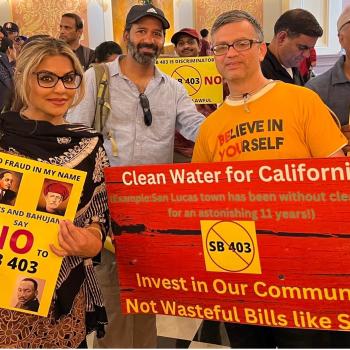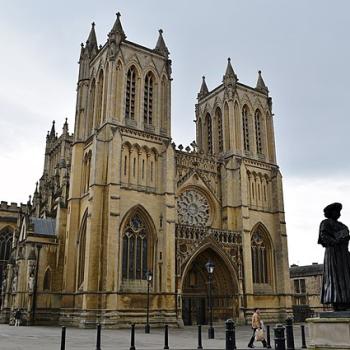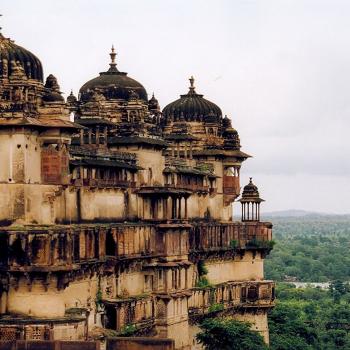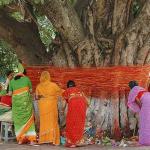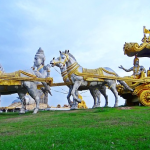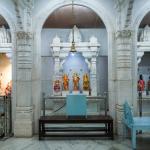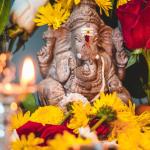KM Munshi’s death anniversary is approaching in a few days. I thought a post on his efforts to rebuild the Somnath temple would therefore be apt. Here’s a short history of the temple till today.
History & Location
The linga here is called. Someshwara. Near the temple at Somnath there is a triveni, where the Hiran and Kapila Rivers join with a third, the mystical underground Sarasvati, just before they flow into the sea.
The temple is at the edge of the sea, where the high tides bring the water to the very foot of the temple. Traditions hold that the ocean would, at high tide, rise into the very sanctum of the temple and submerge the Shiva linga.
The oldest name of this tirtha was Prabhasa, meaning “Glorious” or “lustrous”. Prabhasa is mentioned as one of the places visited by the Pandavas during their pilgrimage. It was here, according to the Mahabharata, that Arjuna sought out Krishna, who agreed to serve him as charioteer during the impending battle. And it was here, that the Yadavas fought amongst themselves and perished.
Krishna left his body just a short distance from here, shot in the heel by a hunter. This spot is called Bhalka Tīrtha or Dehotsarga, literally where Krishna “gave up his body.” It has been restored as a place of pilgrimage by the same Somnath Trust that rebuilt the Somnath Temple. Today, pilgrims visit this grove, where they will find a marble image of Krishna reclining. There is also a small sun temple near the main temple of Somnath.
2000 years ago, it is known that Prabhasa was an important place of pilgrimage of the Pashupata sect of Shaivas.
Somnath’s Mythology
Soma, the Moon, married twenty-seven wives, but neglected all of them in favor of one, the beautiful Rohini. Daksha, the father of all these women, cursed Soma to waste away with consumption.
The Moon waned to almost nothing, and all the gods and sages were miserable because of the unremitting darkness of the night sky. Finally, they brought the Moon to Prabhasa to worship Shiva.
Soma worshipped an earthen linga for many months, until Shiva was pleased with him and granted him a boon to alleviate his curse. The boon was this: Soma would wane day by day during one half of the month and then would wax to his full glory, day by day, during the other. Shiva also pledged to dwell there forever in Prabhasa.
On Amavasya, it is said that the Moon himself bathes where the Sarasvati meets the sea, and so do countless pilgrims.
Destruction & Reconstruction
This temple was destroyed in 1026 during the raid by Mahmud of Ghazni.
Persian chronicles of Mahmud’s looting and burning of Somnath describe its beauty and its treasures, its columns of teak from Africa, studded with jewels. These chronicles also describe the fierce defence of the temple, in which fifty thousand Hindus were killed. Mahmud broke the linga into pieces, burned down the temple, and hauled away its riches.
KM Munshi wrote that the destruction of Somnath “has been burnt into the collective sub-conscious of the race as an unforgettable national disaster.”
But even within a few decades after the raid of Mahmud of Ghazni, Sanskrit inscriptions give evidence of continued pilgrimage to Somnath.
In the twelfth century, it is said that a Shaiva named Bhava Brihaspati, was sent by Shiva himself to persuade the Chalukya king Kumarapala to renovate the temple. The Chalukyas ruled over parts of Karnataka and Central India, and their kings built many famous temples, including the Badami cave temples and the Bhutanatha temple at Badami.
The temple was plundered and destroyed in the fourteenth century by Allauddin Khilji’s forces, and again in the fifteenth century it was converted briefly into a mosque.
In the early eighteenth century, Somnath was destroyed once again, this time by the forces of Aurangzeb.
In total, the temple is said to have been destroyed 17 times.
At the end of the eighteenth century, the great temple-building Queen Ahalyabai Holkar of Indore (who also rebuilt Kashi Vishwanath) wanted to rebuild a temple at Somnath. She found, however, that it was impossible to build upon the old ruins, so she built a temple a short distance away. For 150 years, the site of the old Somnath was silent. In 1922, K. M. Munshi visited Somnath for the first time
In the months following independence in 1947, K. M. Munshi and Sardar Vallabhai Patel, both Gujarat natives, became vocally and publicly committed to the reconstruction of Somnath. They established the Somnath Trust for the project and began to raise support and money.
Prime Minister Nehru was at pains to dissociate the government of India from this undertaking, writing to all the state chief ministers in 1951, as the opening ceremonies of the temple approached:
“You must have read about the coming ceremonies at Somnath temple. Many people have been attracted to this and some of my colleagues are even associated with it in their individual capacities. But it should be clearly understood that this function is not governmental and the Government of India as such has nothing to do with it… we have to remember that we must not do anything which comes in the way of our State being secular.… It is important that Governments should keep the secular and non-communal ideal always before them”
The opening ceremonies however were very popular, and public officials were present from throughout India, including the President Rajendra Prasad, who presided at the opening ceremony. He insisted, over Nehru’s objection, that he would also preside over the opening of a mosque or a church. The Gujarat government also supported the opening.
The new temple, built in the Chalukya style, was dedicated in 1951, although work on the temple and the surrounding site continued into the 1990s.



